This entry includes a walking tour! Take the tour.
Introduction
Text-to-speech Audio
Images
Artist’s rendering of the First Harrison County Courthouse. People with business in the building would tie their horses to the stone piers.
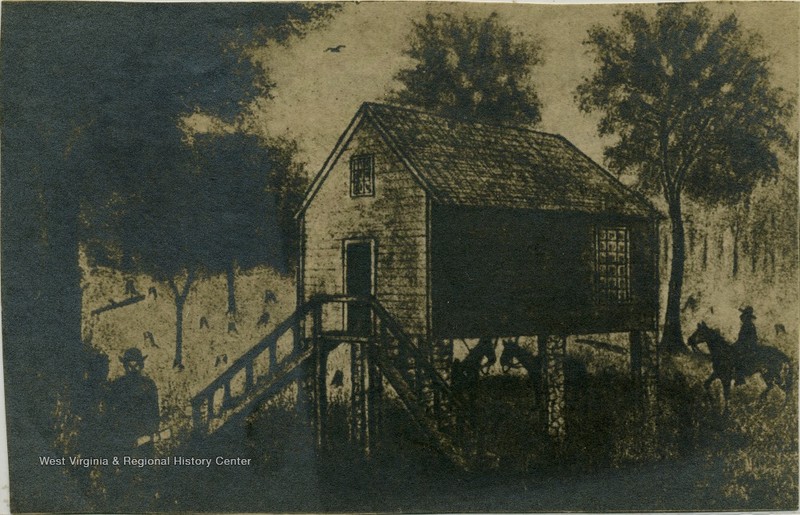
The third Harrison County Courthouse which existed from 1857-1887. Clarksburg's pro-Union meetings occurred at this courthouse.
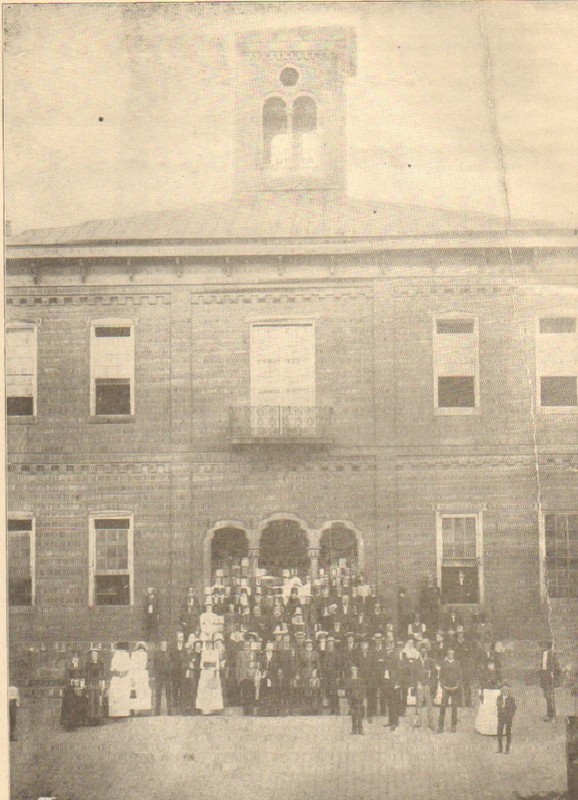
The fourth courthouse, built between 1888 and 1889. Photo taken in 1911.
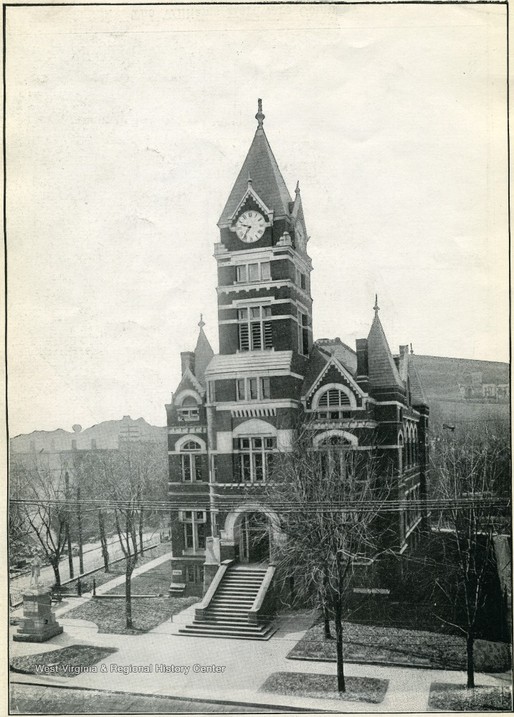
The cornerstone laying ceremony for the fifth and current courthouse in 1931 was heavily attended.
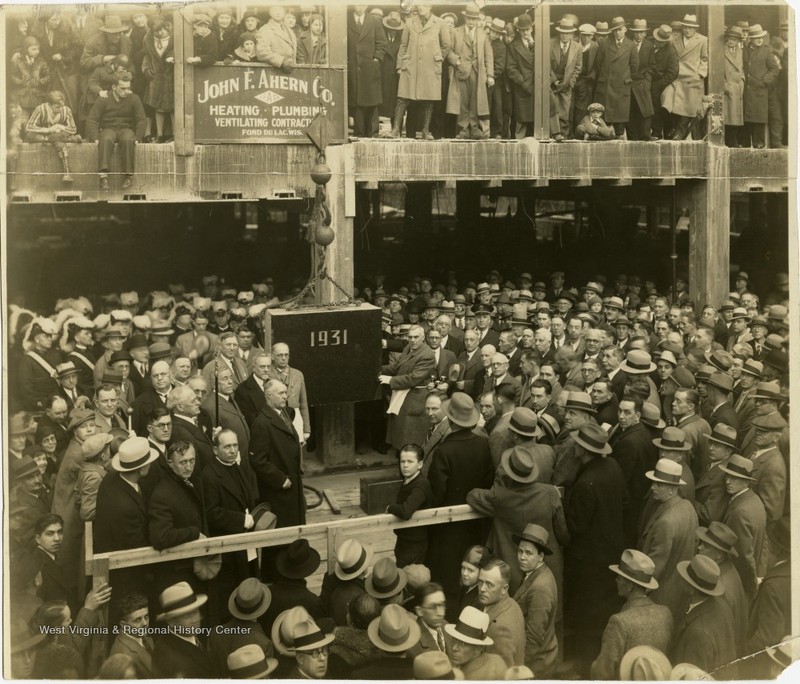
A photo of the current Harrison County Courthouse a few years after its completion in 1932.
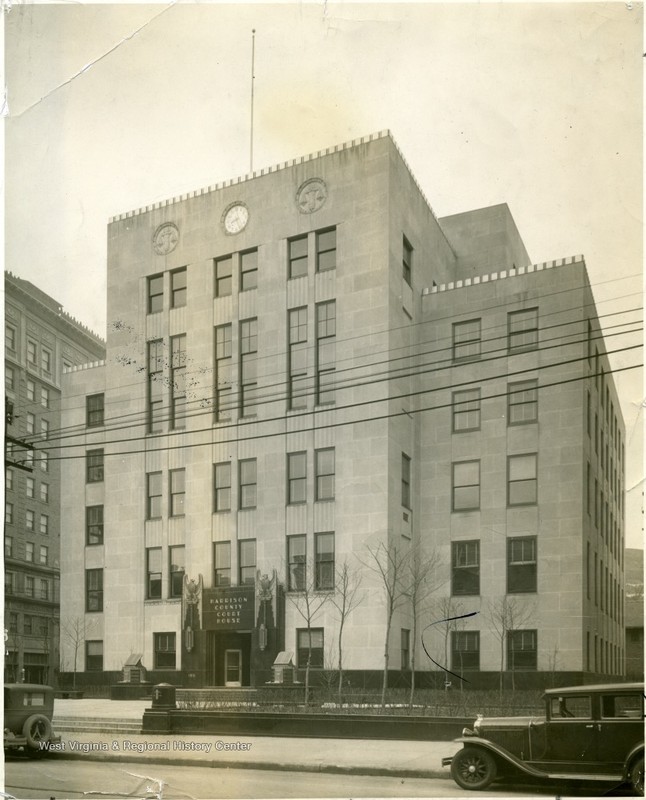

The Harrison County Courthouse today.
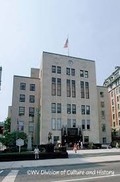
Backstory and Context
Text-to-speech Audio
Following a meeting at the home of George Jackson on July 20, 1784, Clarksburg was chosen as the seat of Harrison County. Three years later, the first courthouse was built at a cost of five hundred fifty dollars. It was located at the corner of Main Street and 2nd Street, roughly a block from its current location. The building was a simple single-room frame construction resting on stone piers. Citizens often tied their horses to the piers when conducting business in the building. By the early nineteenth century, the need for a more substantial building became pressing, and a new courthouse was erected. Located at Main Street and 3rd Street, the site of the current courthouse, the second courthouse building was a two-story brick building. It cost three thousand seven hundred dollars to build. A large tree behind the structure served as a whipping post.
The two-story brick courthouse served Clarksburg for forty-five years. In 1856, it was demolished and another newly expanded building took its place. The third courthouse was also a two-story brick building, though it was larger and featured far more ornamentation, such as a cupola on the roof, wrought-iron balconies, and a bell and clock tower. This courthouse was the site of the Union Meetings, a series of public gatherings to discuss Virginian secession, both before and after this possibility was realized. The most important meeting occurred on April 22, 1861, when 1,200 Clarksburg residents packed the square to discuss Virginia’s act of treason just five days prior. Public opinion was strongly pro-Union, and repeated calls for a pro-Union convention emerged from the meeting. John S. Carlile, a seasoned politician present at the Virginia Secession Convention, also helped organize the Union Meetings. Following the April 22 gathering, he was instrumental in coordinating the First Wheeling Convention, which eventually led to the creation of West Virginia as a state.
A fourth courthouse was constructed between 1888 and 1889 at the cost of forty-six thousand dollars. By far the most ornate structure to date, it featured brick construction, three stories, and Romanesque revival architectural touches. The bell and clock tower from the third courthouse were also preserved and reintroduced on the newer structure. Clarksburg continued to boom in the late nineteenth and early twentieth centuries, so plans were made for yet another new courthouse building — the one you see before you today. A special levy in 1928 raised an astounding seven hundred thousand dollars to finance the construction. Clarksburg architect Carlton C. Wood was commissioned to be the supervising architect, while Cleveland, Ohio architects R.L. Walker and H.F. Horne assisted with the plans. The new nine-story courthouse proved to be the pride of Clarksburg. A cornerstone laying ceremony in 1931 attracted thousands of residents, while an equally lavish dedication occurred after its completion in 1932. John W. Davis, Democratic nominee for president in 1924, gave the principal address at the dedication ceremony.
The fifth and final Harrison County Courthouse is an excellent example of early Art Moderne architecture. Though it developed out of Art Deco, Art Moderne is also a response to the earlier style. While Art Deco architecture is typically opulent and heavily ornamented, Art Moderne is more sleek and austere. Though the Harrison County Courthouse is certainly an Art Moderne building, it retains several Art Deco aspects rarely found in Art Moderne. It was common for Art Moderne buildings to eschew Art Deco’s sharp points in favor of more curvilinear vertices. However, the Harrison County Courthouse clearly maintains bold edges. Furthermore, Art Moderne architecture typically emphasizes horizontality over the soaring verticality of Art Deco. The Harrison County Courthouse is certainly a vertical structure — perhaps this is a result of the space the architects had available. The limestone building’s two most distinctive features are an illuminated clock at the top of the building, which is crowned by a flagpole.
Several monuments, historical plaques, and statues grace the Harrison County Couthouse’s grounds. A historical information plaque provides some information and context on the Union Meetings and John S. Carlile. Near the entrance is a statue of Thomas Jonathan “Stonewall” Jackson, a Confederate general and Clarksburg’s most famous resident, mounted on a horse. Erected in 1985 as part of a centennial celebration, “Honoring the Immigrants” is a tribute to Clarksburg’s heritage. The bow flag staff of the U.S.S West Virginia, which was sunk at Pearl Harbor, also graces the courtyard. Finally, two memorials honor West Virginia veterans: the Memorial to Those Who Served and the Purple Heart Memorial. For over two centuries, the Harrison County Courthouse has continued to serve as the central gathering point of the county.
Sources
Art Moderne, Designing Buildings. January 25th 2021. Accessed March 19th 2021. https://www.designingbuildings.co.uk/wiki/Art_Moderne#:~:text=Art%20Moderne%2C%20also%20known%20as,opulent%20forms%20of%20Art%20Deco..
The Harrison County Courthouse, Clarksburg Visitors' Bureau. Accessed March 19th 2021. https://www.clarksburgvisitorswv.com/courthouse.aspx.
Harrison County Courthouse, West Virginia Department of Arts, Culture, and History. Accessed March 19th 2021. http://www.wvculture.org/shpo/ch/harrison.html.
Haymond, Henry. History of Harrison County, West Virginia: From the Early Days of Northwestern Virginia to the Present. Salt Lake City, Utah. Acme Publishing Company, 1910.
Pauley, Michael J. Clarksburg Downtown Historic District, National Register of Historic Places. February 17th 1982. Accessed March 18th 2021. http://www.wvculture.org/shpo/nr/pdf/harrison/82004794.pdf.
“Drawing of the First Harrison County Courthouse.” West Virginia & Regional History Center. Accessed March 19, 2021. https://wvhistoryonview.org/catalog/013265.
“Harrison County Courthouse.” 1911. West Virginia & Regional History Center. Accessed March 19, 2021. https://wvhistoryonview.org/catalog/006362.
“Laying Cornerstone of Harrison County Courthouse, Clarksburg, W. Va.” 1931. West Virginia & Regional History Center. Accessed March 19, 2021. https://wvhistoryonview.org/catalog/040161.
Waite, Carl F. “Harrison County Courthouse, Clarksburg, W. Va.” West Virginia & Regional History Center. Accessed March 19, 2021. https://wvhistoryonview.org/catalog/005653.
Harrison County Historical Society.
West Virginia Department of Arts, Culture and History. Accessed March 19, 2021. http://www.wvculture.org/shpo/ch/harrison.html.
